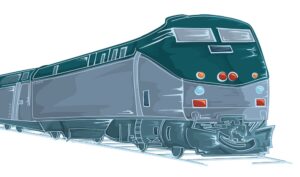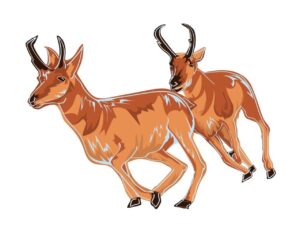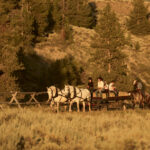A vision for bringing passenger rail back to the rural West
Words by Nick Robinson, artwork by Graham Marema
Steel wheels glide along a track as the conductor announces, “Next stop, Thermopolis!” Outside the window, pronghorn antelope gallop across the sagebrush. The train slows to match their speed and then enters a tunnel. On the other side, striking granite walls of the Wind River Canyon come into view.
This vision of passenger rail travel across Wyoming is purely imaginary, but might it one day become reality? Today, no travelers ride the rails in Wyoming or South Dakota, making them the only two states in the continental United States without passenger offerings. Instead, trains here transport almost anything except humans, while citizens rely on cars to get from one community to the next, and many who can’t drive have no options at all. But what if that wasn’t the case? What if conductor whistles rang out once again, and accessible passenger rail service connected towns in the rural west?
 If Dan Bilka and Charlie Hamilton get their way, that just might happen. The two lead All Aboard Northwest (AANW), a regional passenger rail advocacy group whose vision is to create a transportation network that offers environmental, equity, and economic benefits throughout the northwestern US. The way they see it, folding passenger rail back into the greater transportation fabric could benefit underserved populations and act as a development engine for rural communities across the West.
If Dan Bilka and Charlie Hamilton get their way, that just might happen. The two lead All Aboard Northwest (AANW), a regional passenger rail advocacy group whose vision is to create a transportation network that offers environmental, equity, and economic benefits throughout the northwestern US. The way they see it, folding passenger rail back into the greater transportation fabric could benefit underserved populations and act as a development engine for rural communities across the West.
Passenger rail has a robust history in the region. Trains carried travelers across the western United States starting in the late 1860s. I met Mark Amfahr, a transportation consultant from Minneapolis, while he was in Laramie digitizing a Union Pacific Historical Society collection at the American Heritage Center. “A first-class passenger car would look and feel like this room,” Amfahr said, motioning to the decadent curtains, detailed woodwork, and grandiose western paintings adorning the walls.
 Locomotives required stops to refuel and change crews along routes, Amfahr explained. Key stops grew to depots and became “the reason why people located where they did, and why those communities developed…a base for jobs or employment.” Settlements grew. The Overland and Pioneer Routes, operated by Union Pacific and Amtrak respectively, snaked alongside present-day Interstate 80, serving people in Cheyenne, Laramie, Rawlins, Green River, and Evanston and providing the common traveler access to an ever-growing West.
Locomotives required stops to refuel and change crews along routes, Amfahr explained. Key stops grew to depots and became “the reason why people located where they did, and why those communities developed…a base for jobs or employment.” Settlements grew. The Overland and Pioneer Routes, operated by Union Pacific and Amtrak respectively, snaked alongside present-day Interstate 80, serving people in Cheyenne, Laramie, Rawlins, Green River, and Evanston and providing the common traveler access to an ever-growing West.
Societal shifts following World War II began to alter the transportation landscape. Veteran pilots returned home, and commercial air travel entered the scene. Flying became popular for long-distance journeys, and the automobile was king for short to medium length trips. Funding supporting rural passenger rail linkages dried up in the late 1990s. Ridership dwindled as routes began to disappear. The last Amtrak passenger train to serve Wyoming departed from Green River on May 10, 1997, and all stations closed the next day.
Now, All Aboard Northwest is working to reverse those closures and bring passenger rail to even more small towns across the West.
“We have found the statistic is around 30 percent of the US population doesn’t drive,” says AANW Secretary Charlie Hamilton, who himself is unable to drive. “Either they are too old, too young, they’re too poor, they are disabled, or they are concerned about the future. And that number is only getting bigger.” Offering alternate modes of transportation can attract new visitors for communities hoping to grow in a sustainable manner, Hamilton believes.
“There are the 3 Es. We call them the environmental benefits, the equity benefits, and economic benefits,” Hamilton says. The AANW website lists examples such as reducing automobile pollution, expanding access to services for underserved communities, and bringing in tourists to overnight in small towns. “No matter where you are on the political spectrum, most people will say yes, I can get behind at least two of them. There is a lot of interest in making this happen not only in big cities, but in small places too.”
Toward this vision, AANW organizes an annual “Train Trek” outreach series, where members travel by car meeting with groups interested in establishing passenger rail service. In 2021, the trek centered on Wyoming. Stops included not only historically serviced cities, but towns that were never connected to major cross continental routes. “The smaller communities really got it best,” Hamilton said about towns such as Greybull and Thermopolis, where residents were drawn to the value of being able to travel to larger cities for services not offered in the immediate area. One meeting resulted in a series of letters from Wyoming residents to policymakers at the United States Department of Transportation, each echoing the sentiment, “People live here too.”
According to AANW President Dan Bilka, this was the first time in recent memory that the Department of Transportation heard from Wyoming residents about their desire for passenger rail. Reinstating service is popular on both sides of the aisle, and the Federal Railroad Administration’s Corridor Identification and Development Program aims to identify communities that could be viable candidates for intercity passenger rail. All Aboard Northwest acts as a mediator for communities wishing to submit applications for consideration.
 Imagining a future where citizens of the rural West can ride trains from town to town is not that much of a stretch. Many historic depots still anchor small towns. “[The depot] is that critical access point for the community, but they are also regional hubs, and as they were in history,” Bilka explains. “The depot is the gateway and entryway into the community.” Local leaders are realizing this and are already envisioning the transition back to former use.
Imagining a future where citizens of the rural West can ride trains from town to town is not that much of a stretch. Many historic depots still anchor small towns. “[The depot] is that critical access point for the community, but they are also regional hubs, and as they were in history,” Bilka explains. “The depot is the gateway and entryway into the community.” Local leaders are realizing this and are already envisioning the transition back to former use.
I can imagine myself standing on the platform as a train rumbles idle at Depot Park in Laramie, Wyoming. Doors of the sleek cars slide open and passengers file out. A seated woman wheels herself down a ramp and is greeted by a friend. Kids run to playground equipment at the park while parents sit at a newly built eatery. I hear letters click on the split-flap display board. Listed under departures is Malta, Montana, the endpoint on a north-south route that transects Wyoming. I step aboard and find my seat. The train departs the station, gaining speed as it glides northward. Full steam ahead.
Nick Robinson is an adventurer interested in sustainable modes of transportation. He can be seen cycling around Laramie, Wyoming, on a green vintage Schwinn bike.
Graham Marema is pursuing her MFA in creative writing from the University of Wyoming, with a concurrent degree in environment and natural resources.


